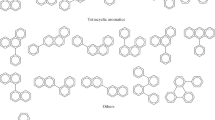Summary
-
1.
The naphthene hydrocarbons, except for five-membered, were identified by their catalytic dehydrogenation and subsequent analysis of the secondary aromatic hydrocarbons. Cyclohexane and its homologs were identified in the benzene fraction of petroleum by the chemical methods and by spectroscopy.
-
2.
After the marked predominance of the methylcyclohexane, 1,3-dimethylcyclohexane predominates among the disubstituted derivatives. After it follows 1,4-dimethylcyclohexane and then 1,2-dimethylcyclohexane.
-
3.
The presence of cyclohexane homologs, from the monosubstituted to tetraalkylcyclohexanes, in the kerosene-gasoil part of the petroleum was established by means of the spectroscopic and picrate methods. Decalin and its homologs were identified. Among the decalin homologs dimethyldecalin predominates.
Similar content being viewed by others
Literature cited
P. S. Makovetskii, Neft. i Gas. Prom., No. 4 (1961), p. 58.
P. S. Makovetskii and D. P. Serdyuk, DAN AN URSR, No. 8, (1962), pp. 10, 1086.
P. S. Makovetskii, Z. S. Smutkina, and D. F. Serdyuk, Khim. i Tekhnol. Topliv i Masel, No. 4 (1965).
N. I. Chernozhukov and L. P. Kazakova, Neft. Khoz., No. 8 (1955), p. 75.
E. F. Yatsenko and N. I. Chernozhukov, Khim. i Tekhnol. Topliv i Masel, No. 3 (1960).
N. D. Zelinskii, Collected Works [in Russian], Acad. Sci USSR Press (1955), p. 271.
G. S. Landsberg, B. A. Kazanskii, et al., Determination of the Individual Composition of Directly Distilled Benzenes by the Combined Method [in Russian], Acad. Sci. USSR Press (1959).
S. R. Sergienko and E. V. Lebedev, DAN SSSR, Vol. 123 (1958), p. 704.
N. G. Adams and D. M. Richardson, Anal. Chem. (1954), p. 129.
G. Eglaff, Physical Contents of Hydrocarbons, Reinhold (1946).
S. S. Nametkin, E. S. Pokrovskaya, and T. G. Stepantseva, DAN SSSR, No. 67 (1949), p. 847; DAN SSSR, No. 78 (1950), p. 715.
E. S. Pokrovskaya, Trudy Instituta Nefti AN SSSR, No. 4 (1954), p. 47.
R. A. Friedel and M. Orchin, Ultraviolet Spectra of Aromatic Compounds, New York (1951).
K. Stair, Research Inst., NBS, Vol. 42, No. 6 (1948), p. 587.
A. S. Balley et al., Inst. Petr. (1947), p. 503.
L. Ruzicka et al., Helv. Chem. Acta (1949), p. 153.
Author information
Authors and Affiliations
Additional information
Translated from Khimiya i Tekhnologiya Topliv i Masel, No. 7, pp. 23–26, July, 1966.
Rights and permissions
About this article
Cite this article
Makovetskii, P.S., Serdyuk, D.F. & Voronina, T.B. Naphthene hydrocarbons of the benzine and kerosene-gasoil fraction of petroleum. Chem Technol Fuels Oils 2, 468–472 (1966). https://doi.org/10.1007/BF00725973
Issue Date:
DOI: https://doi.org/10.1007/BF00725973




